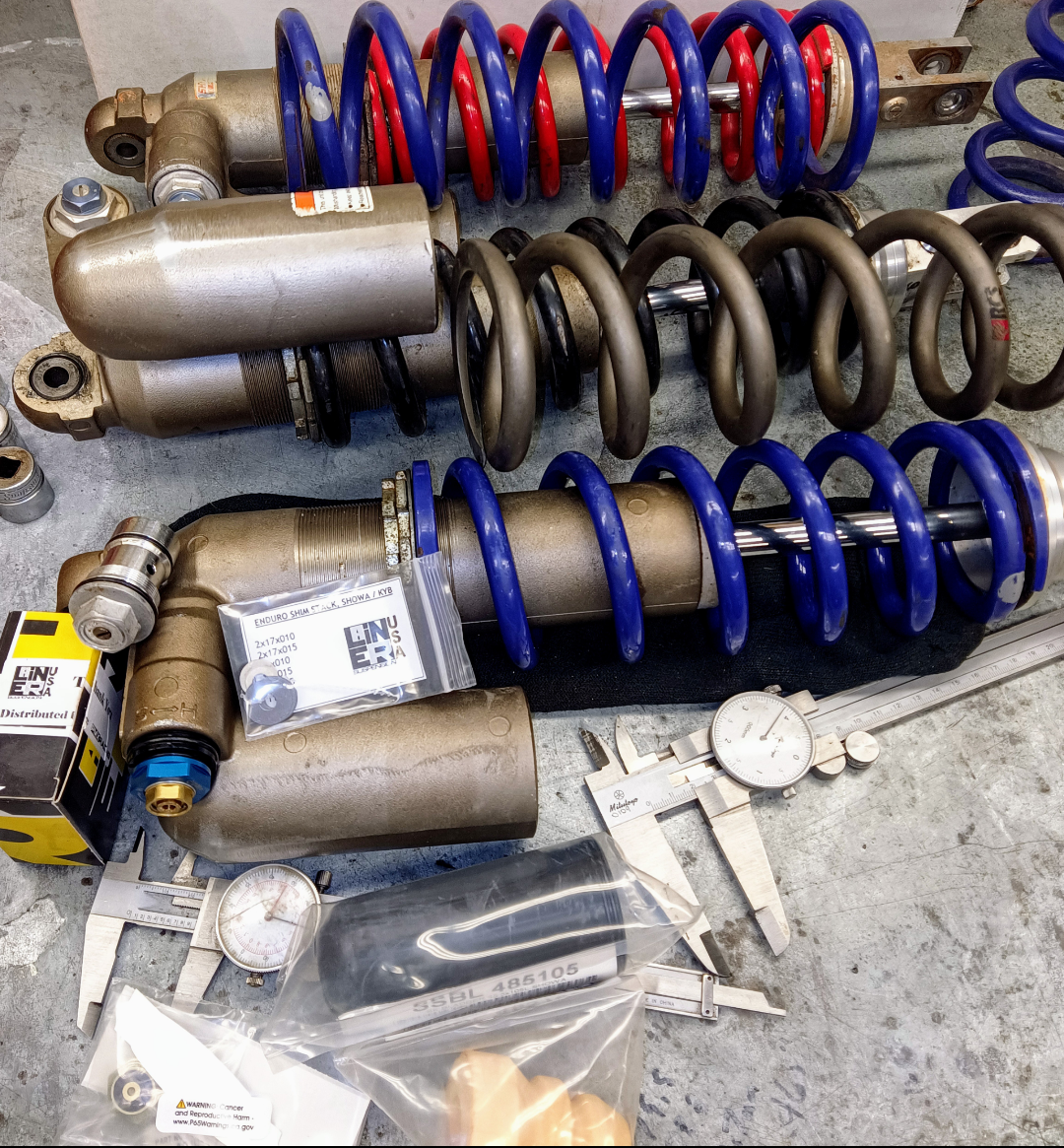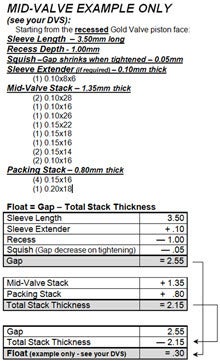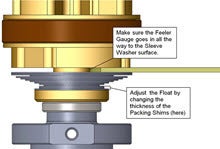To match the Showa Twin Chamber fork upgrade or DRZ400/400E / '02+ DRZ400S fork upgrade, or any '01+ Showa 47mm/48mm coil spring Twin Chamber fork upgrade, I've been developing a recipe for a building a 50mm Showa rear shock fitment onto the H-Series KDX chassis for a while now, out of the best parts dimensionally from multiple various models of Showa 50mm shocks, & making some good progress recently...
The '01-'04 RM125 Showa has been successfully fit by a few others, although the length of the shock is around 23mm or 24mm longer than the stock KDX shock at around 448-449mm overall length center to center, so the preload must be backed out all the way on the spring (& shorter lower spring seat from a DRZ400 or '98-'00 RM is preferred) as the shock has to compress 11mm to even fit within the frame/rocker linkage limitations of the KDX200H/220R.

I've got an '02 DRZ400E Showa shock in my testbed '99 KDX220R in my shop (temporarily retired - awaiting rebuild) currently. This shock is about 449mm overall length, and has a 6mm shorter body and roughly a 2mm shorter shaft than the '01-'04 RM125 Showa (but a 5.5mm longer clevis due to the mounting bolt hole being drilled lower, could be welded up and machined to clone the '01-'04 RM125 bolt hole location) but requiring significant filing/beveling of the inside horizontal front facing edge in the crotch of the clevis to not interfere with the rocker, otherwise it won't lay down forward enough to mount the top shock bolt.
The stock DRZ400/400E/400S shock still has to be compressed roughly 9mm-10mm to fit into the KDX. I've measured with the rocker linkage nearly topped out (able to slide a piece of paper between the frame and the rocker), and around 440mm or 17.27" is the absolute maximum length for a swap shock to prevent hard top-outs of the rocker link arm against the H-Series KDX frame. 439mm would give a better margin, and move the rocker top-out starting position to move the shock spring further away from it's potential interference with the engine case swingarm/engine mounting bolt area. Internal spacers and/or sealhead lowering spacers should be used to achieve this, and it's best for maximum travel range to mix and match the components which best fit - primarily shortest lengths of the modern components - shock body & clevis.

If a single shock were to be chosen as the best, right now I'd say that would be the 2002-2024 DRZ400/400E/400S shocks. The standard offroad/dual sport DRZ400/400E/400S shafts are roughly 2mm shorter than the '01-'04 RM125 shafts, and bodies 6mm shorter.
This will give around 11.4" of suspension travel, and around 1.5" of increased ride height. Stock KDX is 11.8" travel.
The DRZ400SM Supermoto model shocks have a taller shock piston (16mm thick vs 12mm irrc) which has it's shaft step machined down further to accommodate the piston on otherwise the same length shaft as the DRZ400/400E/400S models, effectively lowering the shock internally by 4mm further than the offroad and dual sport models. This brings the DRZ400SM down to around 444mm overall length - still requiring compressing slight to install or else running 4mm to 6mm of internal lowering spacer stack to avoid constant smacking of the rocker arm link against the KDX frame on top-out situations. This will yield around 10.65" of total rear wheel travel if installed with the stock DRZ400 lower clevis (I believe the 400SM clevis is identical, but have not been able to verify). The shorter '01-'04 RM125 clevis or welded up & machined / shortened DRZ clevis really is key to gaining back the proper shock travel to achieve 11.8" of travel.
Welding up and redrilling the DRZ400 lower clevis higher like the '01-'04 RM 125 or else swapping a clevis from an '01-'04 RM125 donor shock (and beveling the top front edge of the crotch of the clevis in order to properly lay down forward to mount the upper shock mounting bolt without being restricted by the rocker/clevis interference) will take the approximate length of the DRZ400SM shock down to 438.5mm roughly, which will yield around 11.4" or 11.5" of travel, and alao will no longer be banging the rocker linkage against the frame when topping out the suspension.
, but will leave you with around 124mm shock shaft travel vs a preferred 127mm to 130mm.
The stock KDX shock allows 300mm rear wheel travel or 11.8" wheel travel as advertised
edit - corrction on travels, KDX200H/220R achieves this 11.8" wheel travel through 118mm shock shaft travel*** - the spring seat bottoms out on the seal head bottom out bump cap with a portion of the shaft never even seeing the bump cap stop).
The KDX's fork travel is listed at 11.4", so even 11.4" rear travel will still be a fair match to this. Running a longer chain and having the axle further back in the adjustment range will slightly improve hill climb stability, add slightly to plushness of the rear suspension, AND will bring the travel measurement back to near what the original advertised KDX's travel is, although 11.5"-ish vs 11.8" is a very negligible amount.
I will likely alter the frame's upper shock mount this winter when the frame is torn down for painting and Yamaha bolt-on footpeg mounts (and Trail Tech kickstand 2010 YZ footpeg/kickstand combo mount!), bump it rearward 5mm, and raise it upward 5.5mm to utilize the full available 130mm of shaft travel of the '01-'04 RM shafts.
These shocks with stock 112.5mm pull rod dogbone links will yield around 1.8" taller rear ride height than stock. Adding KLX300 117mm pull rod suspension link "dog bones" and their matching linkage bolts (slightly wider for the steel versions, significantly wider bolts for the aluminum versions) will drop the ride height increase back down to around 7/8" taller than a stock KDX, which is a great match to most fork swap upgrades after sliding the triples down over the fork tubes to correct the steering geometry and front ride height to match the rear.
I wouldn't recommend any aftermarket lowering links any longer than this due to getting into more significant altering of the suspension leverage ratio curve. 115mm KLX650R and 117mm KLX300 links will "correct" the linkage geometry slightly from the longer shock rocking the rocker linkage further back into deeper leverage ratio than the stock KDX shock's length would ever give it.
One note on the DRZ shocks - the reservoirs clear everything fairly well, and you can run the KX250F Showa ('06+) aftermarket extended reservoir caps, but not any of the longer ones for other models due to exhaust clearance), but... the compression adjuster housing portion of the shock body contacts the KDX airbox slightly. I'd recommend using a heat gun to dimple the side of the airbox at this location, but this really is no big deal at all. The adjuster is still slightly shrouded by the side plate plastics just like the OEM KDX's KYB shock is.
Also, all of these shocks will require the donor bike's lower (or upper) shock mounting bolt as they use a nut and bolt attachment, longer bolt being needed, vs the KDX using a threaded clevis. Two upper KDX shock mounting bolts will also work perfectly, but the lower KDX mounting bolt is too narrow.
Additionally, the upper shock mount pocket for the KDX shock is significantly wider than the Showa shocks, and you will need somewhere around roughly 2mm of washers/spacers on each side of the upper shock bearing in order to sandwich it into the KDX frame properly.
I've also found that the Lainer Suspension aftermarket compression adjuster upgrade advertised for '09+ (-'16?) KX250F Showa shocks does in fact fit the older Showas despite their tech support guy saying that some of the older Showas are not compatible. It actually fit perfectly into the '98 RM250 shock body (& I believe'96-'97 also, the 46mm piston/body diameter version of the '98 & otherwise exact length dimensions), so I assume it will have good chances of fitting all of the older 50mm Showas.
It's well known that the KYB and especially Showa dual compression adjusters marked high vs low speed damping are really just a low speed / low mid speed damping adjustment. Also, they have a shim stack inside of them that have a significant amount of influence on the shock's compression damping. These aftermarket adjusters give them more of a true high speed damping adjustment range, and the two different circuits don't affect each other as much as the OEM style. Additionally, Lainer also sell an "enduro" shim stack for these for $10, as they are set up for MX use out of the box,
One other tip, the '02+ DRZ shocks have the dual compression adjuster, but '00-'01 have the older single compression adjustment. The DRZ400SM model came out later, so all SM shocks have the OEM dual adjuster.
Also pictured is a Race Tech rebound separator valve (Lainer sells these as well), which is a mandatory upgrade for any custom shock setup/rebuild, as this allows different flow rates for rebound vs compression through the shaft, which corrects the design flaws of nearly all shocks so that adjusting the rebound no longer has any effect on altering the compression damping flow rate. Lainer Suspension also sells nearly the exact same rebound separator product.

I've asked an eBay seller to measure an '07-'09 RM-Z 250 Showa shock overall body length for me to compare it to the DRZ400 / '98-'00 RM bodies (same length, different reservoir and compression adjuster positioning), but I think it'll be similar length body to the '01-'04 RM125 Showa body
edit - its several millimeters longer), but with even better reservoir positioning (compression adjuster bore and reservoir mounting position is angled upwards to get the reservoir away from the near-frame-interference that the 98-00 RM125/250 & '01-'04 RM125 reservoir has, although all of the RM/RMZ compression adjusters are located in a better position than the original KDX's or the DRZ400 Showas or the '06+ KX250F Showas. The '05+ RM125/250 / '06+ KX250F / '07+ RM-Z 250 Showas have an extended clevis which absolutely won't work on the KDX swap, BUT they also are so long that they leave a blank slate for us to potentially shorten and redrill the mounting holes in the shortest possible configuration basically like the '01-'04 RM125's position. The body lengths on this newer generation seems to be longer like the '01-'04 RM, but I cannot verify although photo approximations tell me yes same or slightly longer, not short like the DRZ4 or 98-00 RM bodies.
One other perk to the '05-'08 RM125/250 and '07+ RM-Z 250 shocks is that they use a larger shock shaft. This is not done for strength reasons, but rather to allow more internal area in the hollow shaft for rebound needle orifice shock oil flow. The downfall is no OEM parts breakdown listing from Suzuki for any of the shocks, whereas if you need piston bands or o-rings, OEM sealhead parts, etc, you can look up an '06+ KX250F and use those parts for the '98-'00 RM125/250, '01-'04 RM125, and all DRZ400 shocks as they all use the slightly smaller shaft. Race Tech sells all the sealhead rebuild and bladder parts individually, but since they sell their own aftermarket Gold Valve pistons, they list no parts such as piston bands or o-rings for the OEM pistons, and I believe I'll find that all of these Showa shock pistons will already be of high quality and flow rate and not necessarily needing to be upgraded, although MX Tech does sell a nice low friction piston band upgrade. MX Tech and Lainer both I believe sell a shorter than stock piston as well, with matching piston band, the Works/A-Kit type piston that goes into the factory race team builds, as these are lighter in weight and give a very minuscule advantage due to this.
If one were to modify the KDX frame's upper shock mount to raise it 5mm and bring it back towards the airbox rubber boot 5-7mm or so for better spring clearance to the engine case rear swingarm mounting bolt, The KDX200H/220R can achieve 12.5"+ rear suspension travel with the RM shock bodies, preferably the '98-'00 RM body. This setup with an added inch or so of ground clearance using the KLX 115 or 117mm links and a '98 RM fork or '05+ RM/KX250F inverted fork will make the H-Series KDX really the ultimate in woods weaponry. More travel, 438-440mm shock giving the rocker ratio more initial leverage/plushness over stock, keeping with the KDX's 26.5 degree steering angle and shorter wheelbase (although I'm beginning to like the idea of a longer wheelbase from a more rearward chain/axle adjustment length on the steep steep technical slow hill climbs to help prevent looping out), really will make the KDX find it's ultimate form.
****One thing to note is that the larger shocks' springs, when the suspension is topped out, will interfere with the KDX engine case swingarm mounting bolt area if the spring is not rotated in a way to span around this. Once a rider is seated on the bike, the rider sag / race sag puts the shock further rearward due to the rocker arm rotating under compression, and this is out of the picture. This is a good reason to make sure that you have the proper washer at the top of the spring between the preload collar and the spring, or an aftermarket Pivot Works shock thrust bearing kit, or a Diverse Spring teflon thrust washer, to ensure that the shock spring rotation under compression (they all rotate slightly when compressed) occurs mainly on the upper portion of the coil spring.
If and when I modify the KDX frame's upper shock mount location higher up, I'll also bring it back a few millimeters towards the airbox rubber carb inlet boot, to better clear the cases.
I'd also have no problem slightly clearancing the engine case through bolt mounting area in this area ip to 5mm material removal (it's 7mm thick in the center of the swingarm pivot bolt engine mount area), but being careful to not daylight the bore of the engine/swingarm mount thru-bolt, as I don't want to be taking on water into that area as the steel bolts already can rust seize in there if not removed for regular suspension bearing servicing and greased. My KX500 titanium swingarm pivot bolt is exempt from rusting like steel, but I still would not take off enough to break into the bore of the swingarm/engine case mounting bolt. I'm also hoping to run this RCS / Renton Coil Spring titanium 4.9kg shock spring. Titanium shock springs use thicker wire, which will increase the o.d. of the spring, but luckily I believe they typically use less coils as part of the same logic, so I'll have a wider spacing between the coils if not choosing to do any upper shock mount relocation or engine case clearancing.
Granted the rear suspension swap test fitting has made me realize that the rear shock length and travel is one of the greatest benefits to building a KX125/KDX220 hybrid...as well as the 5lbs or so weight reduction the KX components give vs the KDX chassis components, although I'd still probably fork swap any '96-'02 KX125 woods bike / hybrid build personally...
I still may seek out a KX125 for a woods bike build, preferably a '97-'98, or a purple '96 with '97-'98 swingarm, or possibly a '99-'02 with retro '96-style purple graphics, but I think first I'd be throwing some money at the engine to build an ultralight and potent woods ported high compression woods weapon "KDX134R" or '96-'97 "KDX139R" (using a Honda CR125R piston and a '94 KX125 head to match up to the specs of the '94-'97 long rod KX125 engines with the CR piston and '94 head). This would be my purple '96-styled Kawasaki version of the modern YZ125X woods bike...but staying true to my Kawasaki fanaticism!






